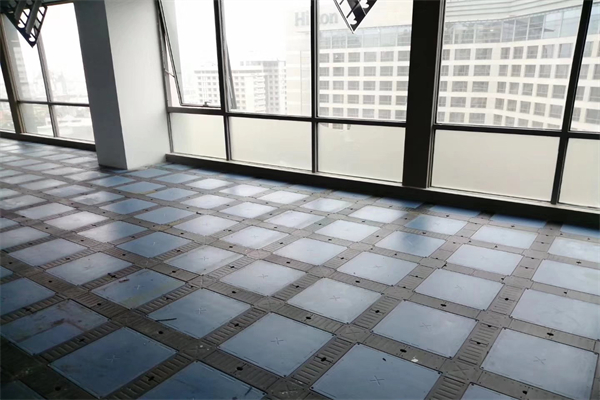Optimizing Workspace Efficiency with Low-Profile Raised Floors

In today’s fast-paced world, businesses are constantly seeking innovative ways to enhance workspace efficiency. Whether designing an office, data center, or high-security facility, a flexible and organized environment is essential. One of the most effective solutions for optimizing space while ensuring seamless infrastructure management is Low-Profile Raised Floors (LPRFs). These specialized flooring systems offer numerous advantages, particularly in commercial and IT settings where space optimization and easy access to critical systems are crucial.
What Are Low-Profile Raised Floors?
Low-Profile Raised Floors are an advanced flooring system that elevates the surface above the building’s concrete slab, creating a concealed space for routing cables, pipes, and essential utilities. Unlike traditional raised floors, which are often taller and used in large-scale data centers, LPRFs are designed with a minimal height—typically ranging from 2 to 6 inches—making them an ideal choice for environments where space is limited but adaptability is required. These systems offer a sleek, unobtrusive way to manage wiring and infrastructure while ensuring easy access for maintenance and future upgrades.
Ideal Applications for Low-Profile Raised Floors
Low Profile Raised Floors are highly versatile and suitable for a range of commercial and IT environments. These flooring systems not only optimize space but also enhance safety and organization. Here are some of the top applications:
1. Data Centers and Server Rooms
Effective management of cables, cooling systems, and power distribution is essential in data centers and server rooms. Low-profile raised floors provide a hidden channel for cables while allowing for improved airflow, enhancing cooling efficiency and reducing the risk of overheating. Additionally, the easy-access design simplifies maintenance and system upgrades, making it a cost-effective long-term solution.
2. Control Rooms and Emergency Response Centers
High-pressure environments like 911 dispatch centers and command rooms require seamless access to critical communication and power systems. LPRFs create an organized, clutter-free workspace by neatly concealing cables and network connections. This setup not only improves workflow and ergonomics but also allows for quick adjustments as technology and operational needs evolve.
3. Healthcare Facilities
Hospitals and healthcare environments rely on an extensive network of wiring for medical equipment, lighting, and HVAC systems. Low-profile raised floors support these critical infrastructures while maintaining a sterile, organized space. Additionally, they help manage moisture control, contributing to a cleaner and safer environment.
4. Retail Spaces and Exhibition Halls
Retail and exhibition spaces often require flexible layouts that can be easily modified for changing displays and events. LPRFs provide a discreet way to house electrical wiring, lighting, and other utilities, ensuring a sleek, uncluttered appearance. Businesses can effortlessly reconfigure their layouts without the need for costly renovations.
5. Industrial and High-Security Environments
For industrial facilities and high-security spaces where data and communication lines need to be both accessible and discreet, LPRFs offer the perfect solution. They allow technicians to reach essential systems without disrupting daily operations, making them an ideal choice for secure government facilities, manufacturing plants, and research laboratories.
Key Benefits of Low-Profile Raised Floors
1. Maximized Space Efficiency
By utilizing the underfloor space for cabling and infrastructure, LPRFs free up valuable floor space for workstations, equipment, and essential operations. This efficient design eliminates clutter and enhances overall workspace functionality.
2. Flexibility and Scalability
Business needs evolve, and so should your infrastructure. LPRFs allow for easy reconfiguration, making it simple to add or reroute cables, power lines, and other systems without major renovations. This adaptability is particularly beneficial for industries that require frequent technological upgrades.
3. Enhanced Safety and Aesthetics
A clutter-free workspace not only looks more professional but also reduces tripping hazards caused by exposed cables. By neatly concealing wiring under the floor, LPRFs contribute to a safer and more organized work environment.
4. Improved Airflow and Cooling Efficiency
For data centers and IT facilities, proper airflow is crucial in preventing overheating. The space beneath raised floors allows for efficient cooling system integration, reducing the risk of equipment failure and enhancing overall energy efficiency.
Conclusion
Low-Profile Raised Floors are an intelligent and practical flooring solution for businesses looking to maximize space, enhance organization, and maintain operational flexibility. Whether implemented in data centers, healthcare facilities, retail environments, or high-security spaces, LPRFs provide a modern, adaptable infrastructure that grows with your business needs. Investing in a well-designed raised flooring system ensures long-term efficiency, safety, and scalability, keeping your workspace future-ready in an ever-evolving technological landscape.





